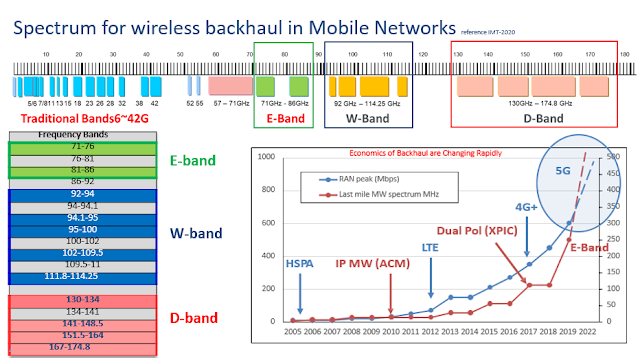e-Band improtance & Key to the 5G Revolution
Consumers today demand ever faster wireless. Although wireless engineers have multiple tricks up their sleeves to meet this demand, they can achieve only so much. To deliver the gigs customers crave, more spectrum is required
V band (60 GHz) and E band (70/80 GHz) are open to all , with abundant spectrum available to deliver on the promises of 5G.
Good news for india is that probably with 5G spctrum allocation E-Band will be alloted to 5G spectrum buyers along with 3.5GHz or 26GHz spectrum for backhaul of 5G Radios
The 60 GHz V band, which is unlicensed, has 14 GHz of contiguous spectrum (57 GHz to 71 GHz). The 70/80 GHz paired E band adds another 10 GHz of spectrum for a total of 24 GHz. These V and E bands are open to everyone, and equipment for them is available today from a rich ecosystem of suppliers.
Below are some statistic from IMT-2020
During past 10 years microwave BH evolution describe below points
1. MW capacity needs for Mobile Operators increased x 15 for delivering increased peak speeds
2. MW Spectrum in the 6 – 42 GHz is not always enough for delivering today LTE peaks; that’s why offload to E-Band spectrum is taking place
3. Most of the links in bands below 23 GHz[>70%]
4. >5Mn MW links world wide
5. Significant regional differences deriving from rain intensity statistics
5.1 Europe mostly on 26 and 38 GHz after 15, 18 and 23 severely crowded
5.2 Far East and Latin America mostly on 7/8, 15, 18 and 23 GHz
5.3 India mostly on 15GHz
6. E-Band growing fast
7. Huge potential in tropical countries (i.e. India,..) in still untapped bands above 23 GHz and E-band
Evolution of the Backhaul Requires an Evolution of Rules too
During the past 10 years
MW capacity needs for Mobile Operators increased x 15 for delivering increased peak speeds
MW Spectrum in the 6 – 42 GHz is not always enough for delivering today LTE peaks; that’s why offload to E-Band spectrum is taking place
Looking to next 10 years
LTE / LTE-A and 5G backhaul needs can are supported by
Using the ample available E-Band spectrum
Making available wider channels in MW spectrum below 42 GHz
E-band spectrum fees shall take into account Mobile Operators needs (1-10 Gbps) in terms of peak speeds
Licensing schemes should incentivize spectrum efficiency from geographical perspective
Below are some performance test results for e-Band in india in Dense Urban clutter
RSL Variation hourly to see environmental world noise impact on e-Band
Key Point- 5dBm variation need to consider for busy hours
Throughput Corelations in e-Band is very intresting and following a linear equation
Key Point
Peak e-Band Throughput[Mbps]= 16.47 * Peak Utilization of e-Band + 0.99






Comments
Post a Comment